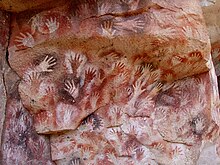Stencil
The stencil (from Latin extergere, to clean), a very primitive technique more recently identified with the stencil (from English stencil), is a type of printing or decoration from a template, tracing or "climb" with a cut-out drawing or pattern, a method that allows the represented image to be reproduced in series. Among its many fields of application, stenciling in tile decoration stands out as an industrial resource. In the context of engraving it is often referred to by the French term pochoir.
An almost prehistoric resource, modern stenciling derives from decorative methods developed in different parts of the world. From delicate Japanese stencils to bold and intricate African designs. From the naive simplicity of Dutch folk art to Victorian formality.
Technique
One of the most common ways to do it is by cutting the desired image on cardboard (since it is a comfortable support for crafts due to its balance between rigidity, cost and ease of cutting); the drawing appears as an open space with solid areas around it. The stencil thus obtained is placed on a new sheet of paper and the paint is applied over the entire surface, so that the areas of paint that reach the lower sheet are limited by the stencil. There are different methods to apply the paint: with a stencil brush (a small amount of paint is applied), a foam roller, or aerosol to create fine and delicate drawings.
History
The oldest known stenciling is found in Spain, where a 6,000-year-old panel of hands has been found. Stenciling has been used since ancient times to duplicate decorative designs on walls, ceilings, and tissues. It was very common in China and Japan to mark packages with seals and calligraphy. This system has also been used to color fiber engraving, etching or engravings, using different templates for the different colors.
Although the stenciling process was used as far back as ancient Rome, it became especially popular in the United States during the 1960s, when many artists used pure colors and sharply contoured silhouettes as a means of expression. This technique became very popular with the so-called street art (with artists like Banksy, Shepard Fairey, Blek le Rat).
Speeches and rhetoric in stencilling
The urban intervention with stencil has connections with two main aspects: on the one hand, it captures the artistic attitude of the stencil design, and on the other, it aims to convey messages of protest against the political system, abuse of power, advertising and society of consumption. Here, the author of the stencil transmits his resource through the image seeking to attract the public through speeches that even dialogue between the same intervention; thus, the stencilist assumes an active political role by participating in the discussion.
The speech that is created in the stencil can be shared and reproduced thanks to the templates used. Thus, phenomena that occur in a place can be displayed worldwide when the stencils are reproduced in different locations. Examples of this are the proliferation of stencils in Argentina in 2001 as a result of the economic crisis, and the massive use of Disney War (satirization of George W. Bush with Mickey Mouse ears) following the declaration of war by the United States. to Iraq.
Another aspect of stenciling in urban interventions is the borrowing in which images that participate in another discourse are brought into a new context to address the topic of discussion. The new message, then, can ridicule and add coherence to the message.
Contenido relacionado
Emily Watson
Stan Lee
Fred Zinneman


